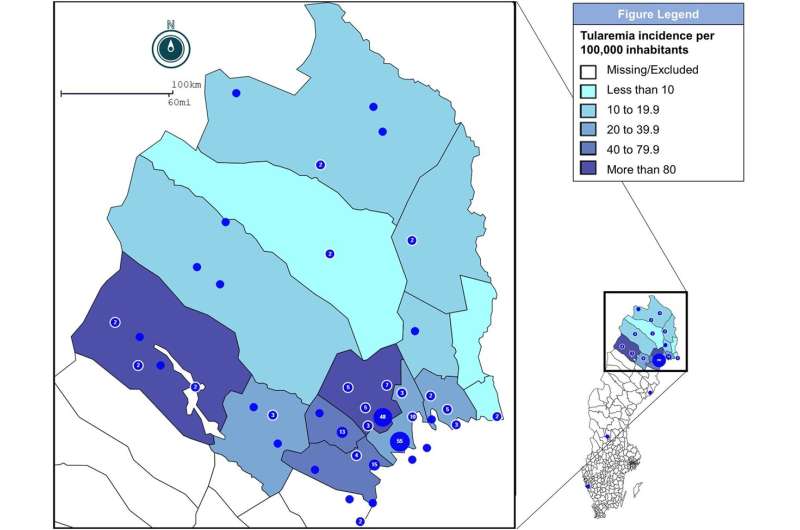This article has been reviewed according to Science X's editorial process and policies. Editors have highlighted the following attributes while ensuring the content's credibility:
fact-checked
peer-reviewed publication
trusted source
proofread
Early and targeted treatment is important for tackling tularemia: Study

A new study at Umeå University in collaboration with Sunderby Hospital in Norrbotten County supports the recommendation to use ciprofloxacin for treatment of tularemia. It also identifies a need for more awareness about the disease among health care workers and the public to start effective antibiotic treatment early. The study is published in Clinical Infectious Diseases.
"In our study, we saw that 15% of study participants required retreatment even after appropriate antibiotics, especially those who had a longer duration between contracting tularemia and the start of correct antibiotic treatment. A few patients with persistently swollen lymph nodes despite antibiotics needed surgery to drain them, often with a prolonged healing process," says Dr. Martin Plymoth, MD, who is affiliated with the Department of Clinical Microbiology at Umeå University and first author of the study.
Tularemia is an infectious disease that can manifest in several different ways: hard-to-heal wounds, swollen lymph nodes, fever, eye inflammation, pneumonia and bacteremia. On average, around 300–500 cases are reported annually throughout the country, and northern Sweden is disproportionately more affected. Fluctuations in cases vary largely between years, and so do the geographical areas that are affected.
In Sweden, the spread of infection occurs mostly during the summer. Contact with infected animals (especially voles and hares) and contaminated water can lead to infection, although mosquitoes are suspected to be the main vector of infection in Sweden. Tularemia can also present as pneumonia through inhalation of bacteria.
Tularemia is treated with antibiotics, but due to the rarity of the disease, large scale studies comparing antibiotic treatments have not been possible to conduct. Antibiotics commonly used to treat skin and soft tissue infections and pneumonia are known to be ineffective against tularemia. In combination with the many ways the disease can manifest itself, this can lead to extended delays in time to diagnosis and correct antibiotic treatment.
In this study, the research team from Umeå University and Sunderby Hospital, in Luleå, Sweden, examined individuals in Norrbotten County who had tularemia during the period 2011 to 2021. During these years, Norrbotten experienced the second (2015) and third (2019) largest outbreaks of tularemia in Sweden. Most cases were reported in the area around Luleå and Boden, while the highest prevalence was found in the municipalities of Boden and Arjeplog.
The researchers identified 830 cases of tularemia during this period, just over half of whom participated in the study by answering a questionnaire and underwent a review of their medical records.
"We identified ulceroglandular tularemia, i.e., hard-to-heal wounds on the arms, legs, or neck/face with swollen lymph nodes as the most common form of the disease," says principal investigator Tomas Gustafsson, attending physician in infectious diseases medicine at Sunderby Hospital and researcher at the Department of Clinical Microbiology at Umeå University.
"Pneumonic tularemia was also common and was often initially mistaken for pneumonia caused by other bacteria or even cancer. Tularemia was common in all age groups among both men and women, but was most prevalent in the group 40 to 60 years of age."
Most cases were diagnosed in primary care centers around the county. 15% of patients were admitted to hospital, but serious infections were uncommon, and no fatalities were reported. Although serological blood tests are available for tularemia, these can be negative up to two weeks after onset of symptoms. Alternatively, so-called PCR tests can be done on wound swabs.
A high level of clinical suspicion is therefore needed by health care professionals. Antibiotics that are known to be ineffective against tularemia were prescribed to about 20% of patients initially because the physician suspected another disease; the proportion was even higher outside the epidemic years 2012, 2015 and 2019.
The researchers saw that individuals who had a longer time between contracting tularemia and appropriate antibiotic treatment tended to be re-treated more often, but that individuals who received the antibiotic ciprofloxacin tended to have less need for re-treatment.
The results support the recommendation to use ciprofloxacin as first-line treatment for tularemia and identify a need for increased awareness of tularemia among health care professionals and the general public to be able to commence effective antibiotic treatment early.
However, the retrospective study design is not ideal to make recommendations regarding antibiotic treatment, length of treatment, and need for surgical interventions, according to the researchers. To answer this, they would have to carry out a randomized controlled trial which tests different treatment options against each other.
"In future research, we also hope to be able to develop diagnostic scoring systems using clinical signs such as swollen lymph nodes and laboratory values such as white blood cells, which could give physicians an early indication of the likelihood of tularemia as opposed to other diseases. Based on this, clinical tools could be developed to help health care professionals identify tularemia cases early and start appropriate treatment," says Martin Plymoth.
"Perhaps the time is ripe to conduct a randomized clinical trial of different treatment options for tularemia in which case, we would need to conduct it in collaboration with several different centers in northern Sweden given the unpredictable and unusual nature of the infection," says Tomas Gustafsson.
More information: Martin Plymoth et al, Targeting Tularemia: Clinical, Laboratory, and Treatment Outcomes From an 11-year Retrospective Observational Cohort in Northern Sweden, Clinical Infectious Diseases (2024). DOI: 10.1093/cid/ciae098




















